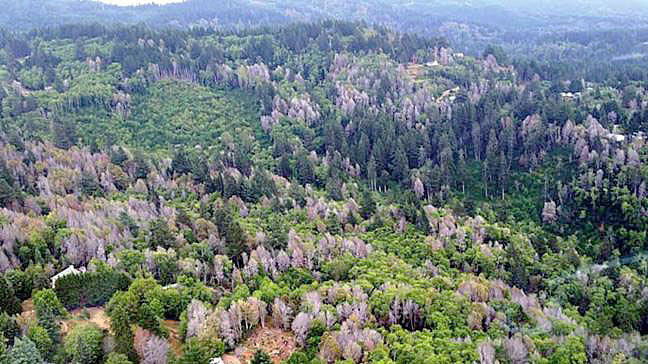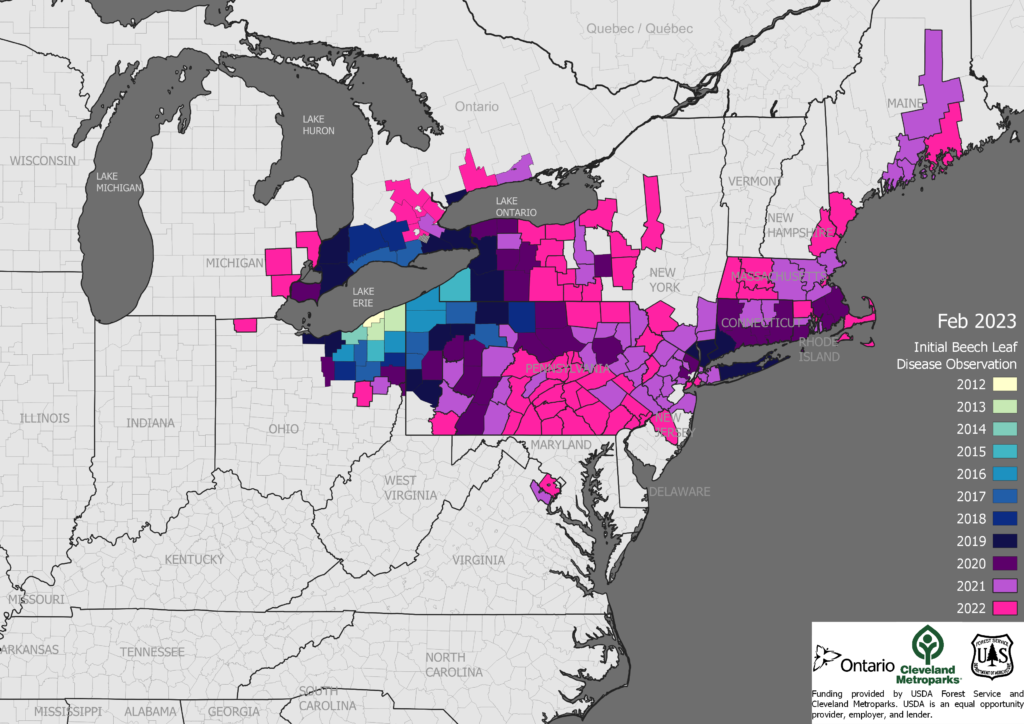
In March I asked your help in asking Congress to fund USDA programs that protect forests from non-native insects and pathogens. The Congress has now taken major steps to specify funding for Fiscal Year 2024 – which begins on 1 October. Both the House and Senate Appropriations committees have adopted their bills. They differ substantially. When Congress returns from its August recess in September, it will face many difficulties in negotiating the final spending levels – not just the different funding levels but also attached “riders” dealing with social and political issues, most of which have nothing to do with invasive species. [Some of the riders to seek to restrict application of the Endangered Species Act to several species, e.g., sage grouse and grey wolf.]
USDA APHIS
As you know, USDA’s Animal and Plant Health Inspection Service (APHIS) is responsible for preventing introduction of pests that harm agriculture, including forests; and for immediate efforts to eradicate or contain those pests that do enter. While most port inspections are carried out by the Department of Homeland Security Bureau of Customs and Border Protection, APHIS sets the policy guidance. APHIS also inspects imports of living plants. In the table below, I provide information on funding for key APHIS programs in FY23, the Administration’s request for FY24, the funding level the Center for Invasive Species thought necessary, and the House and Senate funding levels.
The earlier blog link has additional information: the FY22 funding levels and a fairly long justification for funding these APHIS programs. I never posted a blog discussing USFS funding due to my trip to Europe.
Appropriations for APHIS programs (in $ millions)
| Program | FY 2023 | FY 2024 Pres.’ request | CISP ask | House bill | Senate bill |
| Tree & Wood Pest | $63 | $64 | $65 | $55.6 | $62.6 |
| Specialty Crops | $216 | $222 | $222 | $224.5 | $217.9 |
| Pest Detection | $29 | $30 | $30 | ? | ? |
| Methods Development | $23 | $23 | $25 | ? | $21.8 |
| Emerg. Preparedness | $44 | $45.2 | NA | $44.6 | $48 |
| Contingency fund | $514 | $543 | $514 | $514 |
I have not seen a report from the House Committee so I don’t know whether that body prioritized any invasive species issues.
The Senate report included this statement re: Sudden oak death
“The European strain 1 [EU1] and the North American strain 1 [NA1] of the sudden oak death pathogen are major threats to western Douglas-fir/tanoak forests, resulting in quarantine restrictions that threaten U.S. forests and export markets for log shipments and lily bulbs. The Committee recommendation includes no less than the fiscal year 2023 funding level to improve understanding of EU1 and NA1 strains of the sudden oak death pathogen and treatment methods to inform control and management techniques in wildlands.”
Appropriations for USFS programs (in $ millions)
| Program | FY 2023 | FY 2024 Pres.’ request | CISP ask | House bill | Senate bill |
| Forest Health Protection | |||||
| Federal Lands | $32 | $17 | |||
| Coop Lands | $51 | $33 | |||
| Research & Development | $349.1 | $349.1 | $275 | $307.3 | |
| Forest Inventory | $30.2 | $30.2 | $32.2 | $32.2 | |
| Work on 10 invasive spp | $.5 | $4.4 | $8.5* | 0 | 0 |
* CISP ask was intended as first step to increasing funding for invasive species to 5% of R&D funds. See the March blog for an explanation.

Senate report = Sudden Oak Death. “Since 2001, USFS has been treating SOD infestations on public lands in Oregon and California, in cooperation with Bureau of Land Managemebt. The Committee expects USFS continue these efforts; it provides $3M for SOD treatments and partnerships with States and private landowners.”
Urban & Community Forestry.—”The bill provides $40 M for urban and community forestry. The Committee recognizes the critical need to restore and improve urban forests due to dominance of exotic invasive woody species. USFS should prioritize regional multi-organizational collaborations to support conservation efforts that help trees adapt to and offset climate change, which model best practices for effective urban and community forestry grants. The Committee also expects the program to prioritize tree-planting in socially disadvantaged and historically underserved communities with low canopy coverage, including Tribal communities.”
Summary of Justifications: The Costs of Introduced Pests
Introduced pests threaten many forest products and ecosystem services benefitting all Americans. Already, the 15 most damaging non-native pests threaten at least 41% of forest biomass in the “lower 48” states. In total, these 15 species have caused an additional annual conversion of live biomass to dead wood at a rate similar in magnitude to that attributed to fire (5.53 TgC per year for pests versus 5.4 to 14.2 TgC per year for fire). Fei et al.; full citation at end of blog.
These pests also impose significant costs that are borne principally by municipal governments and homeowners. As more pests have been accidentally introduced over time, these costs have risen.
Pathways of Introduction
The many tree-killing wood-boring pests arrive in inadequately treated crates, pallets, and other forms of packaging made of wood. The March blog presents 2023 data on import volumes and the findings of Haack et al. 2022. The point is, ISPM#15 has fallen short. [See blogs under “wood packaging” category on this site]
APHIS’ Tree and Wood Pests account supports eradication and control efforts targeting principally the Asian longhorned beetle and spongy (= gypsy) moth. Eradicating the ALB normally receives about two-thirds of the funds. The programs in Massachusetts, New York, Ohio, and South Carolina must continue until eradication succeeds. The emerald ash borer continues to spread since APHIS dropped regulations attempting to halt this. EAB was detected in Oregon in 2022; and on Colorado’s western slope in 2023.
Other pests—especially plant diseases like sudden oak death and sap sucking insects like hemlock woolly adelgid—come on imported plants. I noted that no studies have examined the risk of pests arriving on the ~5 billion plants we Americans now import annually (see March blog). The information gap is particularly alarming regarding pathogens. Evidence of failures:
- the recent detection of two strains of Phytopthora ramorum that were formerly limited to Europe in forests of Oregon and California;
- introduction of rapid ‘Ōhi‘a death in Hawai`i;
- and the apparent introduction of the causal agent(s) of beech leaf disease.
APHIS manages damaging pests introduced on imported plants or other items through its Specialty Crops program. The principal example is its efforts to prevent spread of the SOD pathogen through the interstate trade in nursery plants. I am pleased that the Senate report calls on APHIS to focus on that pathogen’s growing genetic diversity.

The Administration did not persuade the Congress to fund a $1 million emergency fund for APHIS – although they did fund both “emergency” and “contingency” programs. I am not certain about the difference.
Furthermore, both chambers of Congress included in their legislation – not in the report – language instructing the Secretary of Agriculture to use his authority to obtain emergency funds from other USDA agencies to address animal or plant health emergencies:
“Provided further, That in addition, in emergencies which threaten any segment of the agricultural production industry of the United States, the Secretary may transfer from other appropriations or funds available to the agencies or corporations of the Department such sums as may be deemed necessary, to be available only in such emergencies for the arrest and eradication of contagious or infectious disease or pests of animals, poultry, or plants, and for expenses in accordance with sections 10411 and 10417 of the Animal Health Protection Act (7 U.S.C. 8310 and 8316) and sections 431 and 442 of the Plant Protection 15 Act (7 U.S.C. 7751 and 7772), and any unexpended bal1ances of funds transferred for such emergency purposes in the preceding fiscal year shall be merged with such transferred amounts.”
The Congress has included this or similar language in appropriations reports for almost two decades, but it has not succeeded in freeing up many funds for countering plant pests. Perhaps placing the language in the legislation rather than the report will help … we will have to see.
In the meantime, I have been working with others to amend the Plant Protection Act to ensure that the emergencies so referenced include threats to forests. See §2 in H.R. 3174 link (Balint, Vermont) and S. 1238 (Welch, Vermont).
SOURCES CITED
Fei, S., R.S. Morin, C.M. Oswalt, and A.M. 2019. Biomass losses resulting from insect and disease invasions in United States forests. PNAS August 27, 2019. Vol. 116 No. 35 17371–17376
Haack R.A., J.A. Hardin, B.P. Caton and T.R. Petrice .2022. Wood borer detection rates on wood packaging materials entering the United States during different phases of ISPM#15 implementation and regulatory changes. Front. For. Glob. Change 5:1069117. doi: 10.3389/ffgc.2022.1069117
Posted by Faith Campbell
We welcome comments that supplement or correct factual information, suggest new approaches, or promote thoughtful consideration. We post comments that disagree with us — but not those we judge to be not civil or inflammatory.
For a detailed discussion of the policies and practices that have allowed these pests to enter and spread – and that do not promote effective restoration strategies – review the Fading Forests report at http://treeimprovement.utk.edu/FadingForests.htm
or